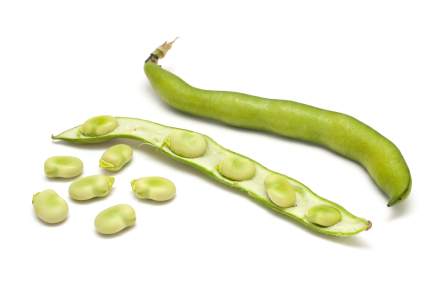
A top performer in the garden, they grow well without much intervention, Broad Beans are one of the few vegies you can plant in the cooler months.
Fast and impressive growth makes these a recommended plant for growing with the kids – daily checks on progress will be well rewarded.
Coles Dwarf is a popular variety, with the more compact size being less likely to get knocked about by the wind.
Growing
Planting time is April to July.
Growing broad beans from seed direct into the garden bed is the only way, sow seed 20cm apart in rows 60cm apart – you don’t want them too close when they get big as the poor air circulation can increase the chance of fungal diseases.
They are pretty forgiving of poor soil quality, as long as there is good drainage they seem to do fine.
When growing broad beans remember that they do take up a big area, so make sure you give them enough room – this might mean choosing a site outside of your raised bed, perhaps in another garden bed against a fence.
Watch our for snails and slugs, they can mow down newly sprouted seeds overnight – use baits or organic controls to manage.
I usually sow twice· – 6 weeks apart· – to keep the beans coming.
Plant in rows between strong stakes that you can run string between as even the dwarf varieties grow to 1m tall and will need support once they are laden down with heavy pods. .
Once sown, winter rains tend to take care of them, however you will need to give them a drink as the temperatures warm up in Spring. Don’t be tempted to water them in once planted (unless it has been very dry) as the seeds may rot in the ground.
Some gardeners recommend that after flowering, you snip off the tops of the plants* to divert energies from producing stems and leaves to producing pods of beans. I would recommend snipping off one row and leaving another alone so you can test this theory for yourself…I didn’t do this one year and still had great results, so I am not sure if this is a proven growing method or not!· Leave a comment and let me know what results you get.

Harvesting Broad Beans
Pick smaller pods can be used unshelled, or leave them to grow larger if you are shelling (or double-shelling). You will be harvesting every 2 to 3 days during spring.
Cooking with Broad Beans
Pods picked young and small can be sliced and cooked whole.
I prefer the double shell method – this involves first shelling the beans from the pod, then after they have been cooked in salted water and slightly cooled, squeezing them out of their greenish grey thick skins to reveal the shiny green bean within. It is a lot more work, but I really like them this way! Actually, this a good reason to plant these with the kids and get them involved – – so that you have helpers when it comes to shelling the beans!
A simple and tasty preparation is to fry Broad Beans up with garlic and chilli to serve as a side dish. Broad Beans are also lovely fried up little bits of speck/bacon/pancetta and a served with a sprinkle of parmesan.
Or gently fry Broad Beans in olive oil, transfer to a bowl and add lemon juice and seasoning, them smash them up and pile onto toasted ciabatta slices and top with a slice of pecorino cheese or crumbled fetta for a magnificent version of bruschetta.
*Don’t throw away any tip prunings, they are lovely tossed through a stir-fry or steamed with Bok Choy and Broccolini and dressed with a garlic or oyster sauce.
